Mathematics Exam > Mathematics Questions > The orthogonal trajectories for the family of...
Start Learning for Free
The orthogonal trajectories for the family of circles touching the y-axis at the origin is ,
- a)x2 + 2y2 + cy = 0
- b)x2 + y2 - cy = 0
- c)x2 - y2 + cy = 0
- d)x2- y2 - cy = 0
Correct answer is option 'B'. Can you explain this answer?
| FREE This question is part of | Download PDF Attempt this Test |
Verified Answer
The orthogonal trajectories for the family of circles touching the y-a...
The equation of family of circles touching y-axis at the origin is
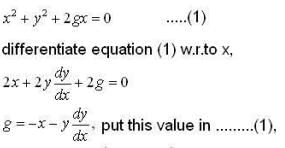
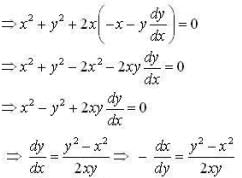
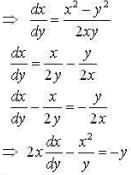
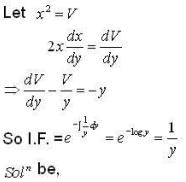
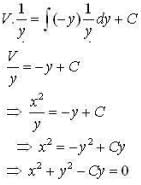
Most Upvoted Answer
The orthogonal trajectories for the family of circles touching the y-a...
Orthogonal Trajectories of a Family of Circles:
The given family of circles touches the y-axis at the origin, which means the center of each circle lies on the x-axis. The equation of a generic circle with center (h,0) and radius r is given by:
(x - h)^2 + (y - 0)^2 = r^2
Simplifying this equation, we get:
x^2 - 2hx + h^2 + y^2 - r^2 = 0
Comparing this equation with the given options, we can see that option B is a possible orthogonal trajectory. Let's verify this.
Verification of Option B:
The equation given in option B is:
x^2 + y^2 - cy = 0
To find the orthogonal trajectories, we first need to find the slope of the given family of circles. The slope of a circle with center (h,0) and radius r at any point (x,y) on the circle is given by:
m = (y - 0) / (x - h)
= y / (x - h)
The slope of the orthogonal trajectory at any point (x,y) is given by the negative reciprocal of the slope of the circle at that point. Therefore, the slope of the orthogonal trajectory is:
m' = -1/m
= -1 / (y / (x - h))
= -(x - h) / y
Now, we substitute x^2 + y^2 - cy = 0 into the equation of the slope of the orthogonal trajectory:
-(x - h) / y = -(x - h) / (sqrt(cy - x^2))
Simplifying this equation, we get:
y = sqrt(cy - x^2)
This equation represents a circle with center at the origin (0,0) and radius sqrt(cy). Hence, it is an orthogonal trajectory of the given family of circles.
Therefore, the correct answer is option B: x^2 + y^2 - cy = 0.
The given family of circles touches the y-axis at the origin, which means the center of each circle lies on the x-axis. The equation of a generic circle with center (h,0) and radius r is given by:
(x - h)^2 + (y - 0)^2 = r^2
Simplifying this equation, we get:
x^2 - 2hx + h^2 + y^2 - r^2 = 0
Comparing this equation with the given options, we can see that option B is a possible orthogonal trajectory. Let's verify this.
Verification of Option B:
The equation given in option B is:
x^2 + y^2 - cy = 0
To find the orthogonal trajectories, we first need to find the slope of the given family of circles. The slope of a circle with center (h,0) and radius r at any point (x,y) on the circle is given by:
m = (y - 0) / (x - h)
= y / (x - h)
The slope of the orthogonal trajectory at any point (x,y) is given by the negative reciprocal of the slope of the circle at that point. Therefore, the slope of the orthogonal trajectory is:
m' = -1/m
= -1 / (y / (x - h))
= -(x - h) / y
Now, we substitute x^2 + y^2 - cy = 0 into the equation of the slope of the orthogonal trajectory:
-(x - h) / y = -(x - h) / (sqrt(cy - x^2))
Simplifying this equation, we get:
y = sqrt(cy - x^2)
This equation represents a circle with center at the origin (0,0) and radius sqrt(cy). Hence, it is an orthogonal trajectory of the given family of circles.
Therefore, the correct answer is option B: x^2 + y^2 - cy = 0.

|
Explore Courses for Mathematics exam
|

|
Similar Mathematics Doubts
The orthogonal trajectories for the family of circles touching the y-axis at the origin is ,a)x2 + 2y2 + cy = 0b)x2 + y2 - cy = 0c)x2 - y2 + cy = 0d)x2- y2 - cy = 0Correct answer is option 'B'. Can you explain this answer?
Question Description
The orthogonal trajectories for the family of circles touching the y-axis at the origin is ,a)x2 + 2y2 + cy = 0b)x2 + y2 - cy = 0c)x2 - y2 + cy = 0d)x2- y2 - cy = 0Correct answer is option 'B'. Can you explain this answer? for Mathematics 2024 is part of Mathematics preparation. The Question and answers have been prepared according to the Mathematics exam syllabus. Information about The orthogonal trajectories for the family of circles touching the y-axis at the origin is ,a)x2 + 2y2 + cy = 0b)x2 + y2 - cy = 0c)x2 - y2 + cy = 0d)x2- y2 - cy = 0Correct answer is option 'B'. Can you explain this answer? covers all topics & solutions for Mathematics 2024 Exam. Find important definitions, questions, meanings, examples, exercises and tests below for The orthogonal trajectories for the family of circles touching the y-axis at the origin is ,a)x2 + 2y2 + cy = 0b)x2 + y2 - cy = 0c)x2 - y2 + cy = 0d)x2- y2 - cy = 0Correct answer is option 'B'. Can you explain this answer?.
The orthogonal trajectories for the family of circles touching the y-axis at the origin is ,a)x2 + 2y2 + cy = 0b)x2 + y2 - cy = 0c)x2 - y2 + cy = 0d)x2- y2 - cy = 0Correct answer is option 'B'. Can you explain this answer? for Mathematics 2024 is part of Mathematics preparation. The Question and answers have been prepared according to the Mathematics exam syllabus. Information about The orthogonal trajectories for the family of circles touching the y-axis at the origin is ,a)x2 + 2y2 + cy = 0b)x2 + y2 - cy = 0c)x2 - y2 + cy = 0d)x2- y2 - cy = 0Correct answer is option 'B'. Can you explain this answer? covers all topics & solutions for Mathematics 2024 Exam. Find important definitions, questions, meanings, examples, exercises and tests below for The orthogonal trajectories for the family of circles touching the y-axis at the origin is ,a)x2 + 2y2 + cy = 0b)x2 + y2 - cy = 0c)x2 - y2 + cy = 0d)x2- y2 - cy = 0Correct answer is option 'B'. Can you explain this answer?.
Solutions for The orthogonal trajectories for the family of circles touching the y-axis at the origin is ,a)x2 + 2y2 + cy = 0b)x2 + y2 - cy = 0c)x2 - y2 + cy = 0d)x2- y2 - cy = 0Correct answer is option 'B'. Can you explain this answer? in English & in Hindi are available as part of our courses for Mathematics.
Download more important topics, notes, lectures and mock test series for Mathematics Exam by signing up for free.
Here you can find the meaning of The orthogonal trajectories for the family of circles touching the y-axis at the origin is ,a)x2 + 2y2 + cy = 0b)x2 + y2 - cy = 0c)x2 - y2 + cy = 0d)x2- y2 - cy = 0Correct answer is option 'B'. Can you explain this answer? defined & explained in the simplest way possible. Besides giving the explanation of
The orthogonal trajectories for the family of circles touching the y-axis at the origin is ,a)x2 + 2y2 + cy = 0b)x2 + y2 - cy = 0c)x2 - y2 + cy = 0d)x2- y2 - cy = 0Correct answer is option 'B'. Can you explain this answer?, a detailed solution for The orthogonal trajectories for the family of circles touching the y-axis at the origin is ,a)x2 + 2y2 + cy = 0b)x2 + y2 - cy = 0c)x2 - y2 + cy = 0d)x2- y2 - cy = 0Correct answer is option 'B'. Can you explain this answer? has been provided alongside types of The orthogonal trajectories for the family of circles touching the y-axis at the origin is ,a)x2 + 2y2 + cy = 0b)x2 + y2 - cy = 0c)x2 - y2 + cy = 0d)x2- y2 - cy = 0Correct answer is option 'B'. Can you explain this answer? theory, EduRev gives you an
ample number of questions to practice The orthogonal trajectories for the family of circles touching the y-axis at the origin is ,a)x2 + 2y2 + cy = 0b)x2 + y2 - cy = 0c)x2 - y2 + cy = 0d)x2- y2 - cy = 0Correct answer is option 'B'. Can you explain this answer? tests, examples and also practice Mathematics tests.

|
Explore Courses for Mathematics exam
|

|
Suggested Free Tests
Signup for Free!
Signup to see your scores go up within 7 days! Learn & Practice with 1000+ FREE Notes, Videos & Tests.


















